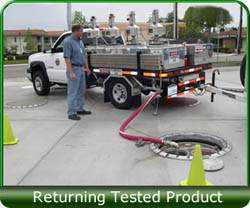 The County's Weights and Measures staff conduct periodic inspections of gasoline service stations to ensure that advertising price signs conform to the requirements of state law including size, color and accuracy. All gasoline dispensing devices are also checked to ensure they contain required information for grade and octane. This program allows consumers the ability to do visual price comparisons from the street.
The County's Weights and Measures staff conduct periodic inspections of gasoline service stations to ensure that advertising price signs conform to the requirements of state law including size, color and accuracy. All gasoline dispensing devices are also checked to ensure they contain required information for grade and octane. This program allows consumers the ability to do visual price comparisons from the street.
Weights and Measures staff also collect random samples of petroleum products such as gasoline, diesel, motor oil, automatic transmission fluid and anti-freeze for submission to California Division of Measurement Standards for testing to determine if the products meet established minimum standards.
When Buying Gasoline...
Good measurement is also important when you buy gasoline and motor fuel. These fuels are sold by volume in gallons or liters. The price you pay for gasoline will depend upon:
- the octane level which may affect the performance of your car;
- the amount you buy; and
- any discounts offered.
A computer in the gasoline pump calculates what you owe based on the amount and the unit price of the gasoline. When comparing prices, be sure to compare gasoline with the same octane rating. Usually, the higher the octane rating, the higher the price. Compare the price of a gallon of gasoline at one station to the price of a gallon of the same octane at another station.
Weights and measures officials routinely check gasoline pumps for accuracy as seen in the photo Vehicle Dispensing Devices on this page. In many areas, they also check gasoline storage tanks to be sure that stations are selling the octane level advertised. If violations are found, the seller can be fined and the product can be removed.

The Retail Motor Fuel Inspection Vehicle
Weights and Measures inspectors use specialized equipment designed to test different types of meters that dispense petroleum products or motor fuels. For public service stations, inspectors use small five gallon containers that are mounted on trucks. These trucks incorporate divided aluminum closed tanks to hold the tested fuel until all pumps have been tested.
This image shows the Weights and Measures Retail Motor Fuel Inspection Vehicle with closed vapor testing system and bottom drop provers.
| 
| 
|
| After the pump test inspection, fuel is returned to underground storage tanks via a hose connected to the trucks specialized pipe plumbing. This image displays the Retail Motor Fuel Inspection Vehicle returning the product back to the to underground storage tanks. | For airports, harbors, truck stops and card locks, inspectors use larger provers that are mounted on trailers. The larger standards accommodate the faster flow of fuel that is dispensed from these meters or pumps. This image shows the Retail Motor Fuel Inspection Vehicle with closed system and towing the Wholesale 100 Gallon Prover Trailer. |
| 
| 
|
| This image shows the Wholesale 100 Gallon Prover Trailer in use at John Wayne Airport. | This image shows a 5-gallon volumetric prover on top and the holding tank on the bottom. |